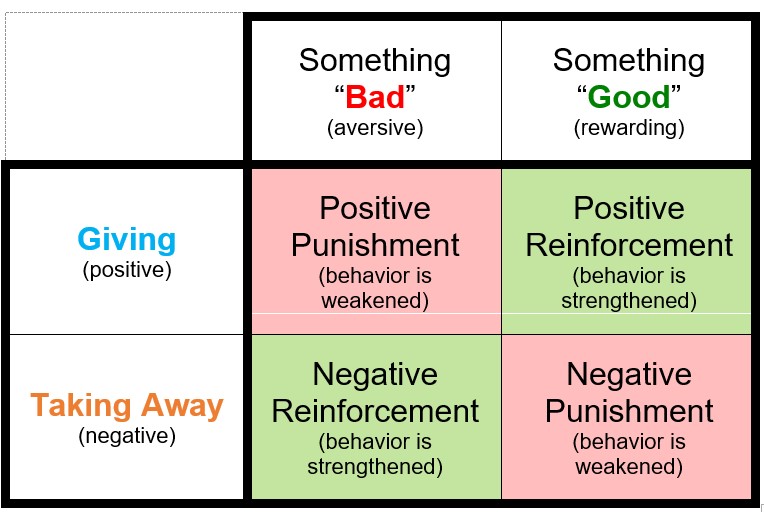Associative Structure of Instrumental Conditioning Which of the Following
Focuses on individual responses and the specific stimulus antecedents and outcomes of those responses. Associative structure of instrumental learning is a function of 1286 RABINAK AND MAREN training insofar as S-S associations control performance early in group F228 322.

Module 6 Operant Conditioning Principles Of Learning And Behavior
This associative structure allows for the animals to keep track of the fact that each.

. G Mackintosh N. The associative mechanisms responsible for the efficacy of Pavlovian stimuli during first- and second-order conditioning have been extensively studied but little is known about the representations underlying instrumental conditioned reinforcement. But modified to generate superficially similar behavior to that following Pavlovian conditioning.
2 Associative Structures in Pavlovian and Instrumental Conditioning soon become evident however that this as-sumption can be hard to sustain or at least that in order to do so it is necessary to pos-tulate associative structures of possibly un-due complexity. Rabinak and Stephen Maren University of Michigan The authors have recently demonstrated that rats with basolateral amygdala BLA lesions acquire Pavlovian fear conditioning after overtraining. Request PDF On Jun 1 2016 Eric A.
In an effort to acquire more information about the associative structure underlying chains we have developed a heterogeneous chain procedure in which procurement and consumption responses can occur at any time but are occasioned by separate SDs. Associative structure focuses on the role of associations while response-allocation emphasizes how respones are distributed. A short summary of this paper.
Which of the following statements correctly identifies a key difference between the associative structure and response-allocation frameworks in describing instrumental conditioning. Subliminal Instrumental Conditioning Demonstrated in the Human Brain. Full PDF Package Download Full PDF Package.
Associative control of responding in discriminated heterogeneous chains. Drug abuse overeating and smoking are all examples of instrumental behaviors that often involve chains or sequences of behavior. That is early in training instrumental responding relies upon action-outcome A-O representations but late in training these responses come to depend on S-R associations Dickinson et al 1995.
E Structure in which the inhibitor acts on the link between CS and US. Underlying associative structure Jocelyn M Richard1 Nakura Stout1 Deanna Acs1. Asked Aug 5 2021 in Psychology by Apebape.
Associative Structure of Operant Conditioning the instrumental response R occurs in the presence of distinctive stimulus S and results in the delivery of the reinforcer outcome O - this allows for several different types of associations. Quarterly Journal of Ex- perimental Psychology 33B 21-31. Thrailkill and others published Extinction and the associative structure of heterogeneous instrumental chains.
Associative Structure of Fear Memory After Basolateral Amygdala Lesions in Rats Christine A. The associative structure has three events that can be associated in a variety of ways. The associative mechanisms responsible for the efficacy of Pavlovian stimuli during first- and second-order conditioning have been extensively studied but little is known about the representations underlying instrumental conditioned reinforcement.
This issue will need to be dealt with in the course of my discussion. Another group of rats underwent Pavlovian. Which of the following types of associative learning is also known as instrumental learning and can be used to alter your own behavior and the behavior of pets children and other adults.
They have found Pavlovian associative linkages and structures embedded in every major facet of instrumental conditioning. -instrumental conditioning involves more than just a response and a reinforcer. Was this article helpful.
These encoded Pavlovian structures include S-R relations predictive stimulus-outcome relations and Pavlovian-like response-outcome expectations Rescorla Continue reading here. Associative structure of instrumental conditioning relies on associations related to classical conditioning outcome serves to strengthenweaken stimulus-response association outcome strengthened SR - outcome weakened SR ignores the stimulus-outcome and. A behavior chain is.
Stimulus context S instrumental response R and response outcome O. Extinction and the associative structure of heterogeneous instrumental chains. The control of appetitive instrumental responding does not depend on classical conditioning to the discriminative stimulus.
The present study investigated the associative stru. Unlike previous studies in instrumental conditioning tasks we found no evidence that the associative structure of fear conditioning changes as a function of training. The associative structure of instrumental conditioning is considered to be a two-part theory where the first part_____ and the second part _____.
The associative structure of instrumental conditioning uses a molecular perspective and is similar to the tradition of Pavlov dealing with relationships among specific stimuli. The instrumental response occurs in the context of specific environmental stimuli. 37 Full PDFs related to.
A form of instrumental conditioning. Classical conditioning is _____ whereas instrumental conditioning is _____. 2University of Vermont United States.
1University of Vermont United States. Following instrumental training of these two different R-O pairs one of the outcomes was then devalued by pairing it in the absence of the opportunity to engage in instrumental responding with LiCl. Associative structure of instrumental conditioning.
Learning and Motivation 6 358-366. Thrailkill EA1 Bouton ME2. Associative Structures in Instrumental Learning 101 Holman J.
Not surprisingly both learning and S-R associations dominates performance of well- groups of rats that received 75 footshocks P75 and U75. However it is not known whether the associative basis of. Associative Structures in Pavlovian and Instrumental Conditioning The associative analysis of.
P 0001 Figure 1. In this task the animal is presented with an auditory cue the discriminative.

Create An Epic Music Department Using This System In 2022 Music Orchestra Classroom

Behavioral And Neurobiological Mechanisms Of Pavlovian And Instrumental Extinction Learning Physiological Reviews

Training Digital Natives To Be The Leaders Of Tomorrow Learning Technology Online Education Education
No comments for "Associative Structure of Instrumental Conditioning Which of the Following"
Post a Comment